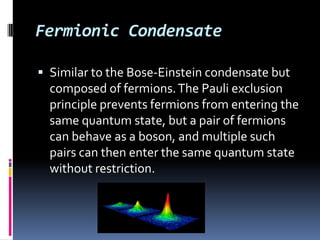States of matter
- 2. Acknowledgement : ï§ Information and pictorial illustrations to create this work have been drawn from class notes, prescribed text books and various internet resources. The author gratefully acknowledges the same. Any objections to the use of internet resources may please be indicated to suddurocks@yahoo.in so that the same can be removed from the illustrations used in this file. ï§ This presentation is created with the sole intention of benefitting a large number of student community. This may not be used for any commercial purpose.
- 3. ï§ The list of states of matter need not be in order. This presentation has all the states of matter and has a line or two about each state of matter.
- 4. Solid ï§ It holds a rigid shape without a container.
- 5. Amorphous Solid ï§ A solid in which there is no long-range order of the positions of the atoms.
- 6. Crystalline Solid ï§ A solid in which the constituent atoms, molecules, or ions are packed in a regularly ordered, repeating pattern.
- 7. Plastic Crystal ï§ A molecular solid with long-range positional order but with constituent molecules retaining rotational freedom.
- 8. Liquid ï§ A mostly non-compressible fluid. Able to conform to the shape of its container but retaining a (nearly) constant volume independent of pressure.
- 9. String-Net Liquid ï§ Atoms in this state have apparently unstable arrangement, like a liquid, but are still consistent in overall pattern, like a solid.
- 10. Liquid Crystal ï§ Properties intermediate between liquids and crystals. Generally, able to flow like a liquid but exhibiting long-range order.
- 11. Gas ï§ A compressible fluid. Not only will a gas conform to the shape of its container but it will also expand to fill the container.
- 12. Super Critical Fluid ï§ At sufficiently high temperatures and pressures the distinction between liquid and gas disappears.
- 13. Plasma ï§ Free charged particles, usually in equal numbers, such as ions and electrons. Unlike gases, plasmas may self-generate magnetic fields and electric currents, and respond strongly and collectively to electromagnetic forces.
- 14. Quantum Hall State ï§ A state that gives rise to quantized Hall voltage measured in the direction perpendicular to the current flow.
- 15. Quantum Spin Hall State ï§ A theoretical phase that may pave the way for the development of electronic devices that dissipate less energy and generate less heat. This is a derivation of the Quantum Hall state of matter.
- 16. Bose Einstein Condensate ï§ A phase in which a large number of bosons all inhabit the same quantum state, in effect becoming one single wave/particle.
- 17. Fermionic Condensate ï§ Similar to the Bose-Einstein condensate but composed of fermions. The Pauli exclusion principle prevents fermions from entering the same quantum state, but a pair of fermions can behave as a boson, and multiple such pairs can then enter the same quantum state without restriction.
- 18. Super Fluid ï§ A phase achieved by a few cryogenic liquids at extreme temperature where they become able to flow without friction A super fluid can flow up the side of an open container and down the outside. Placing a super fluid in a spinning container will result in quantized Vortices.
- 19. Super Solid ï§ Similar to a super fluid, a super solid is able to move without friction but retains a rigid shape.
- 20. Degenerate Matter ï§ Matter under very high pressure, supported by the Pauli exclusion principle.
- 21. Electron Degenerate Matter ï§ Found inside white dwarf stars. Electrons remain bound to atoms but are able to transfer to adjacent atoms.
- 22. Neutron Degenerate Matter ï§ Found in Neutron stars. Vast gravitational pressure compresses atoms so strongly that the electrons are forced to combine with protons via inverse beta-decay, resulting in a super dense conglomeration of neutrons.
- 23. Strange Matter ï§ A type of quark matter that may exist inside some neutron stars close to the Tolman Oppenheimer Volkoff limit (approximately 2 to 3 solar masses). May be stable at lower energy states once formed.
- 24. Quark Gluon Plasma ï§ A phase in which quarks become free and able to move independently (rather than being perpetually bound into particles) in a sea of gluons (subatomic particles that transmit the strong force that binds quarks together). May be briefly attainable in particle accelerators.
- 25. Weakly Symmetric Matter ï§ For up to 10-12 seconds after the Big Bang the strong, weak and electromagnetic forces were unified.
- 26. Strongly Symmetric Matter ï§ For up to 10-36 seconds after the big bang the energy density of the universe was so high that the four forces of nature : strong, weak, electromagnetic and gravitations and are thought to have been unified into one single force. As the universe expanded, the temperature and density dropped and the gravitational force separated, a process called Symmetry breaking.
- 27. Thank You !!! Compiled By : Sudarshan.S.K. Mail Your Feedback And Suggestions For Improvement To : suddurocks@yahoo.in


























